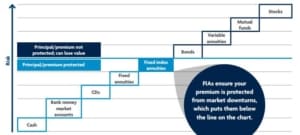Where Do Index Annuities Fit?
Uncertainty is one of the greatest roadblocks that stands in the way of creating a solid retirement plan. It comes in many forms that don’t always relate to the direction of equity markets, interest rates, or general economic forecasts. Yes, uncertainty does affect every person’s ability to know when to make changes but it also affects the decision on which financial products you use in retirement.
Many people have decided not to make changes now because the market is high, rates are low and we have a new political party in control of Washington D.C. While it’s not for me to tell anyone when to make moves, I can help simplify the options for product selection so when your time comes the decision of which products to use has already been made.
I typically stay away from sales literature created by insurance companies. It’s general in nature and oftentimes will give you nothing more than a few photos of a barefoot, silver-haired couple walking hand in hand on a private beach. In reality, there is some good information but rarely does any of it offer specific details that would prove validity for a given situation. Most people are underwhelmed by product brochures so I don’t waste the paper or postage.
But every now and then I see a nice graphic that simply illustrates something that will help people make sense of the options available. That’s where I’m at right now after seeing the chart below that shows an all-around list of every investment option out there, besides commodities. Many times people will see a sales proposal or plan and while it looks good, they don’t really know if it’s the best option. As the saying goes, you don’t know what you don’t know.
The full scope of financial products and opportunities is not quite as extensive as most people believe. Sure there are different variations of stocks, mutual funds, bonds, and annuities but in a general sense the list is quite simple. Below is a list that shows you where index annuities fit in the landscape and the blue line in the middle differentiates assets with principal protection versus those that can lose value.

So it kind of looks like a staircase. At the bottom left is the safest, most tangible asset but you don’t get much out of it besides the security of being able to physically hold on to it if you want. Stick it in the bank and it may not make much interest but you’ll get something and it’s still fully liquid. Earn a little more interest and lock it up in a CD but liquidity takes a hit and rates are too low to make anything meaningful. Fixed annuities are usually an improvement in yield and liquidity but if you want the highest-yielding safe asset and enough liquidity to continually rebalance a portfolio, meet income needs, or even manage RMDs then it has to be a fixed index annuity.
Anything above the blue line puts your principal at risk. Yield depends on external factors for risk-based assets so it’s arguable whether the risky assets will actually return more money. Sometimes risk will pay off and sometimes it won’t. That’s why it takes a careful blend of risk and protection based on your needs, expectations and available assets.
Index annuities are just another asset and I think everyone ought to have at least some money in there. If you disagree and still want to protect some assets then now you have a general list of your alternative options. Best of luck!
Bryan
Further readings
Are Fixed Indexed Annuities a Good Investment?
Who Shouldn’t Buy a Fixed Indexed Annuity
Last Updated on August 15, 2024 by Bryan Anderson


Chart is too small to read. What index annuities do you recommend for income and growth?
Ok Richard – check the link for a full page photo beneath the image. I thought this one was big enough so please forgive me. I’ll do my best to add this at the beginning next time I do something similar.
Bryan, good morning. I have an important question that needs to be answered. I was about to invest in a fixed Index annuity before I found out that the state I am currently in for the winter does not offer the have the protection of the state’s GUARANTY association for NON-RESIDENTS. What is your take on this? Would you just forgo the piece of mind that gives one and take your chances that the companies would stay solvent? Thank you for listening to me, I value your comments….Bryan for any input you may have will be much appreciated.
Russ,
It’s my understanding that any contract is eligible for guaranty protection in the state the application was signed because premium taxes go to that state and that’s what funds the guaranty limits. If you have a summer home in a different state then you can just sign the application in that state and avoid the issue altogether. With a physical address in each place you have the choice as to which state the contract will be issued. If the money goes with a good solid company then it shouldn’t matter but I make no representations on the company recommendation of another salesperson. Give me a call and tell me the states you are dealing with if you’d like a clear answer.